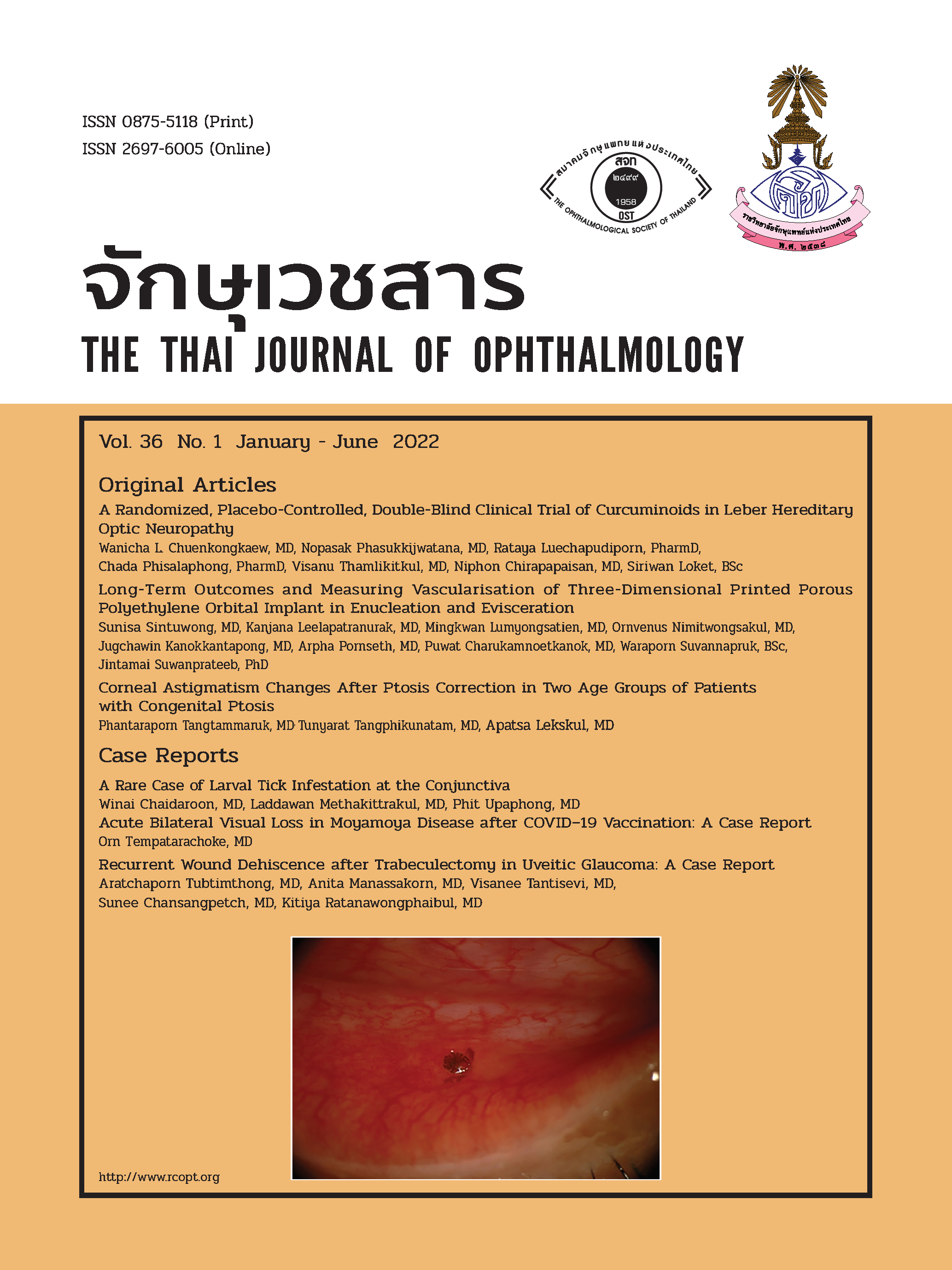การศึกษาโดยการสุ่มตัวอย่างเพื่อเปรียบเทียบการรักษาโรค Leber Hereditary Optic Neuropathy (LHON) ด้วยขมิ้นชันและยาหลอก
คำสำคัญ:
Leber hereditary optic neuropathy (LHON), 11778 mutation, curcuminoidsบทคัดย่อ
วัตถุประสงค์: เพื่อศึกษาการใช้ขมิ้นชันซึ่งมีคุณสมบัติต้านอนุมูลอิสระในการรักษาโรค Leber Hereditary Optic Neuropathy
(LHON) ที่มีการกลายพันธุ์ของยีนไมโตคอนเดรียที่ตำแหน่ง G11778A เปรียบเทียบกับการใช้ยาหลอก โดยการวัดผลระดับสายตาและ
สารอนุมูลอิสระในกระแสเลือด
วัสดุและวิธีการ: ทำการศึกษาโดยการสุ่มตัวอย่างในผู้ป่วยโรค Leber Hereditary Optic Neuropathy (LHON) ที่มีการกลาย
พันธุ์ของยีนไมโตคอนเดรียที่ตำแหน่ง G11778A จำนวน 49 คน (97 ตา) แบ่งออกเป็น 2 กลุ่ม กลุ่มแรกได้รับขมิ้นชันชนิดแคปซูล
รับประทานขนาด 500 มิลลิกรัมต่อวัน กลุ่มที่สองได้รับยาหลอก เป็นเวลา 48 สัปดาห์ติดต่อกันและวัดระดับสายตา ลานสายตา ชนิด
Humphrey ตรวจประสาทตาและจอประสาทตาด้วยคลื่นไฟฟ้า ก่อนและหลังเริ่มให้ยา ในสัปดาห์ที่ 12, 24, 36 และ 48 สัปดาห์
ในกลุ่มที่ 1 และ 2 ตรวจวัดระดับ oxidative stress ได้แก่ ระดับ malondialdehyde (MDA) ในพลาสมา ระดับ superoxide
dismutase (SOD), catalase, glutathione peroxidase (GSH-Px) and total glutathione (GSH) เม็ดเลือดแดง ที่สัปดาห์ที่ 0,
12, 24 และ 48 บันทึกอาการข้างเคียงที่เกิดขึ้นหลังการให้ยา
ผลการศึกษา: จากการสุ่มตัวอย่าง มีผู้ป่วยจำนวน 27 คน (53 ตา) ได้รับขมิ้นชัน และ 22 คน (44 ตา) ได้รับยาหลอก ทำการ
ศึกษาเปรียบเทียบ อายุที่เริ่มมีอาการ ระดับสายตาและระยะเวลาที่มีอาการโรค LHON ไม่พบความแตกต่างของระดับสายตาและสาร
อนุมูลอิสระ ในกลุ่มที่ศึกษาทั้ง 2 กลุ่ม ในกลุ่มขมิ้นชัน พบค่าลานสายตาที่สัปดาห์ที่ 36 และ 48 ดีขึ้นอย่างมีนัยยะสำคัญ (P = 0.027)
ค่า GSH-Px ที่ลดลงแสดงถึงค่า oxidative status ดีขึ้นในกลุ่มขมิ้นชัน ไม่พบอาการแทรกซ้อนในกลุ่มการศึกษาทั้ง 2 กลุ่ม
สรุป: ผลการใช้ขมิ้นชันไม่มีผลต่อระดับสายตา และ ค่า oxidative status ในเลือด ในกลุ่มขมิ้นชัน พบค่าลานสายตาที่ดีขึ้น
อย่างมีนัยยะสำคัญทางสถิติ GSH-Px ที่ลดลงแสดงถึงค่า oxidative status ดีขึ้นในกลุ่มขมิ้นชัน ตลอดจนเกิดความปลอดภัยจึงควร
มีการศึกษาการใช้ขมิ้นขันขนาดสุงในการรักษาโรคดังกล่าวต่อไป
เอกสารอ้างอิง
Man PY, Turnbull DM, Chinnery PF. Leber hereditary optic neuropathy. J Med Genet 2002;39:162-169.
Riordan-Eva P, Sanders MD, Govan GG, et al. The clinical features of Leber's hereditary optic neuropathy defined by the presence of a pathogenic mitochondrial DNA mutation. Brain 1995;118:319-337.
Newman NJ, Lott MT, Wallace DC. The clinical characteristics of pedigrees of Leber's hereditary optic neuropathy with the 11778 mutation. Am J Ophthalmol 1991;111:750-762.
Wang D, Liu HL, Du YY, et al. Characterisation of thickness changes in the peripapillary retinal nerve fibre layer in patients with Leber's hereditary optic neuropathy. Br J Ophthalmol 2020. doi:10.1136/bjophthalmol-2020-316573
Hedges TR, Gobuty M, Manfready RA , et al. The optical coherence tomographic profile of Leber hereditary optic neuropathy. Neuroophthalmology 2016;40:107-112. doi: 10.3109/01658107.2016.1173709
Wang Q, Sun AY, Simonyi A, et al. Neuroprotective mechanisms of curcumin against cerebral ischemia-induced neuronal apoptosis and behavioral deficits. J Neurosci Res 2005;82:138-148.
Kalpravidh RW, Siritanaratkul N, Insain P, et al. Improvement in oxidative stress and antioxidant parameters in beta-thalassemia/Hb E patients treated with curcuminoids. Clin Biochem 2010; 43: 424-429.
Nakamae I, Morimoto T, Shima H, et al. Curcumin Derivatives Verify the Essentiality of ROS Upregulation in Tumor Suppression. Molecules 2019;24(22):4067. doi:10.3390/molecules24224067
Mehta J, Rayalam S, Wang X. Cytoprotective Effects of Natural Compounds against Oxidative Stress. Antioxidants (Basel) 2018;7(10):147. doi:10.3390/antiox7100147.
Brown MD, Trounce IA, Jun AS, et al. Functional analysis of lymphoblast and cybrid mitochondria containing the 3460, 11778, or 14484 Leber's hereditary optic neuropathy mitochondrial DNA mutation. J Biol Chem 2000;275:39831-39836.
Catarino CB, Klopstock T. Use of Idebenone for the Treatment of Leber’s Hereditary Optic Neuropathy: Review of the Evidence. J inborn errors metab screen 2017(5): 1–8 ª doi: 10.1177/2326409817731112
Newman NJ, Yu-Wai-Man P, Carelli V, et al. Efficacy and Safety of Intravitreal Gene Therapy for Leber Hereditary Optic Neuropathy Treated within 6 Months of Disease Onset. Ophthalmology 2021;128:649-60. doi:org/10.1016/j.ophtha.2020.12.012
Karaarslan C. Leber’s Hereditary Optic Neuropathy as a Promising Disease for Gene Therapy Development. Adv Ther 2019;36:3299–3307. doi:org/10.1007/s12325-019-01113-2
Asakawa, T, Matsushita S. “Coloring conditions of thiobarbituric acid test for detecting lipid hydroperoxides.” Lipids 2006;15:137-140.
Oberley LW, Spitz DR. Assay of superoxide dismutase activity in tumor tissue. Methods Enzymol 1984; 105: 457-464.
Pippenger CE, Browne RW, Armstrong D. Regulatory antioxidant enzymes. Methods Mol Biol 1998; 108: 299-313.
Paglia DE, Valentine WN. Studies on the quantitative and qualitative characterization of erythrocyte glutathione peroxidase. J Lab Clin Med 1967; 70: 158-169.
Black AC, Harel O, Matthews G. (2011) Techniques for modeling intensive longitudinal data with missing values. In Conner TS, Mehl M (Eds.). Handbook of research methods for modeling daily life (pp. 339-356). New York: Guilford Press.
Zhuo Y, Luo H, Zhang K. Leber hereditary optic neuropathy and oxidative stress. Proc Natl Acad Sci U S A 2012;109(49):19882-19883. doi:10.1073/pnas.1218953109
Spruijt L, Kolbach DN, de Coo RF, et al. Influence of mutation type on clinical expression of Leber hereditary optic neuropathy. Am J Ophthalmol 2006;141:676-682.
Alizadeh M, Kheirouri S. Curcumin reduces malondialdehyde and improves antioxidants in humans with diseased conditions: a comprehensive meta-analysis of randomized controlled trials. Biomedicine (Taipei) 2019;9(4):23. doi:10.1051/bmdcn/2019090423
Yanpanitch OU, Hatairaktham S, Charoensakdi R, et al. Treatment of β-Thalassemia/Hemoglobin E with Antioxidant Cocktails Results in Decreased Oxidative Stress, Increased Hemoglobin Concentration, and Improvement of the Hypercoagulable State. Oxid Med Cell Longev 2015;2015:537954. doi:10.1155/2015/537954.
Jat D, Parihar P, Kothari SC, Parihar MS. Curcumin reduces oxidative damage by increasing reduced glutathione and preventing membrane permeability transition in isolated brain mitochondria. Cell Mol Biol (Noisy-le-grand) 2013;59 Suppl:OL1899-905.
Lin X, Bai D, Wei Z, et al. Curcumin attenuates oxidative stress in RAW264.7 cells by increasing the activity of antioxidant enzymes and activating the Nrf2-Keap1 pathway. PLoS One 2019;14(5):e0216711. doi: 10.1371/journal.pone.0216711
Ramasamy TS, Ayob AZ, Myint HHL,et al. Targeting colorectal cancer stem cells using curcumin and curcumin analogues: insights into the mechanism of the therapeutic efficacy. Cancer Cell International 2015;15: 96. doi:10.1186/s12935-015-0241.
Haroyan A, Mukuchyan V, Mkrtchyan N, et al. Efficacy and safety of curcumin and its combination with boswellic acid in osteoarthritis: a comparative, randomized, double-blind, placebo-controlled study. BMC Complement Altern Med 2018;18(1):7. doi: 10.1186/s12906-017-2062-z
ดาวน์โหลด
เผยแพร่แล้ว
เวอร์ชัน
- 2023-01-03 (2)
- 2022-08-23 (1)
ฉบับ
ประเภทบทความ
สัญญาอนุญาต
ลิขสิทธิ์ (c) 2022 จักษุเวชสาร

อนุญาตภายใต้เงื่อนไข Creative Commons Attribution-NonCommercial-NoDerivatives 4.0 International License.
The Thai Journal of Ophthalmology (TJO) is a peer-reviewed, scientific journal published biannually for the Royal College of Ophthalmologists of Thailand. The objectives of the journal is to provide up to date scientific knowledge in the field of ophthalmology, provide ophthalmologists with continuing education, promote cooperation, and sharing of opinion among readers.
The copyright of the published article belongs to the Thai Journal of Ophthalmology. However the content, ideas and the opinions in the article are from the author(s). The editorial board does not have to agree with the authors’ ideas and opinions.
The authors or readers may contact the editorial board via email at admin@rcopt.org.

